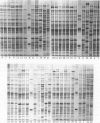Abstract
Forty-two cultures of pseudomonas comprising 28 clinical isolates from a pseudo-outbreak on a Special-Care Baby Unit and 14 reference strains, including 9 type strains, of various Pseudomonas species, were characterized by one-dimensional sodium dodecyl sulphate-polyacrylamide gel electrophoresis (SDS-PAGE) of whole-cell proteins. The protein patterns were highly reproducible and were used as the basis for a numerical analysis which divided the strains into 9 phenons. Two of the 28 clinical isolates were identified by biochemical tests as P. pickettii and their identification was confirmed by SDS-PAGE as they fell in the same phenon as the type strain of the species. The remaining 26 isolates, which could not be identified on phenotypic tests, fell in the same phenon as three reference strains of 'P. thomasii'. The protein patterns provided the first clear evidence that P. pickettii and 'P. thomasii' were separate taxa and that the 'outbreak' was polymicrobial in origin, in line with the probable aqueous source of contamination. We conclude that high-resolution SDS-PAGE of proteins provides an effective method of identifying and differentiating pseudomonads, especially where this cannot be done adequately using conventional biochemical tests.
Full text
PDF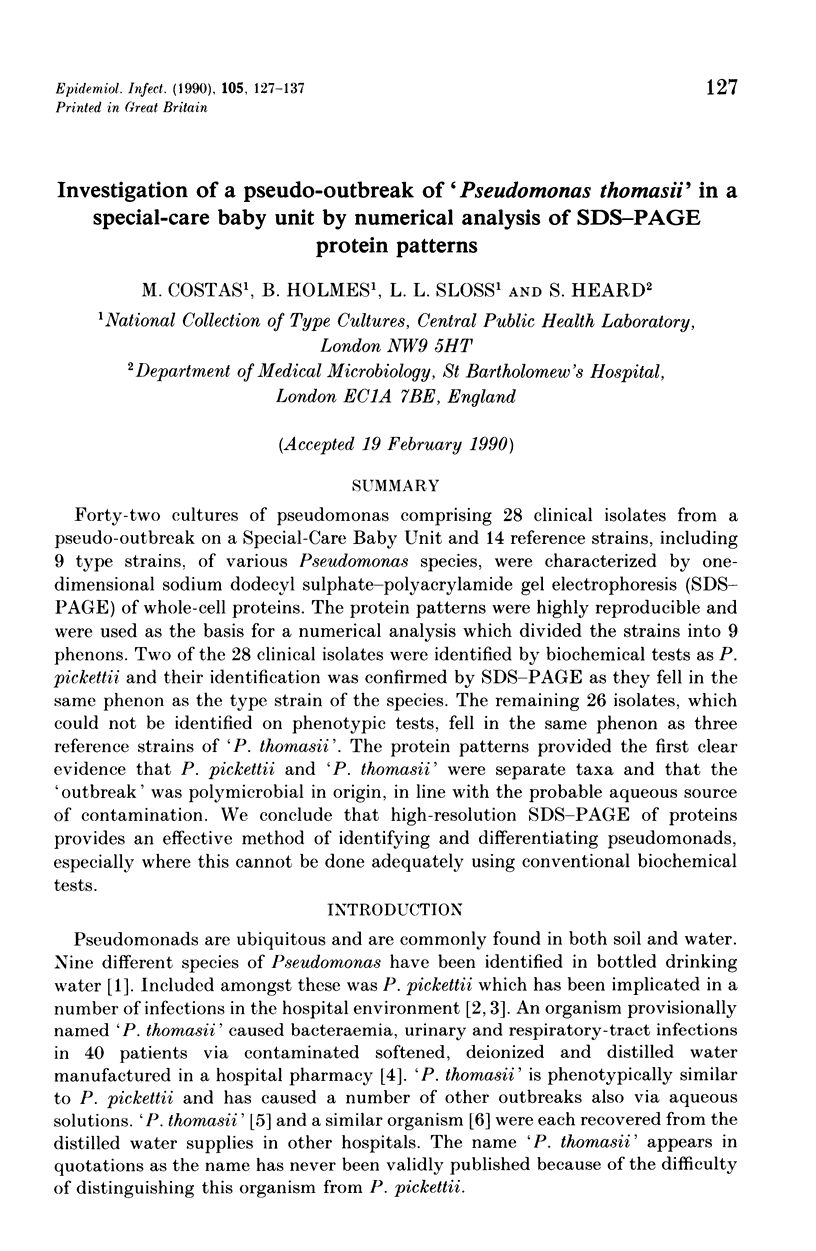
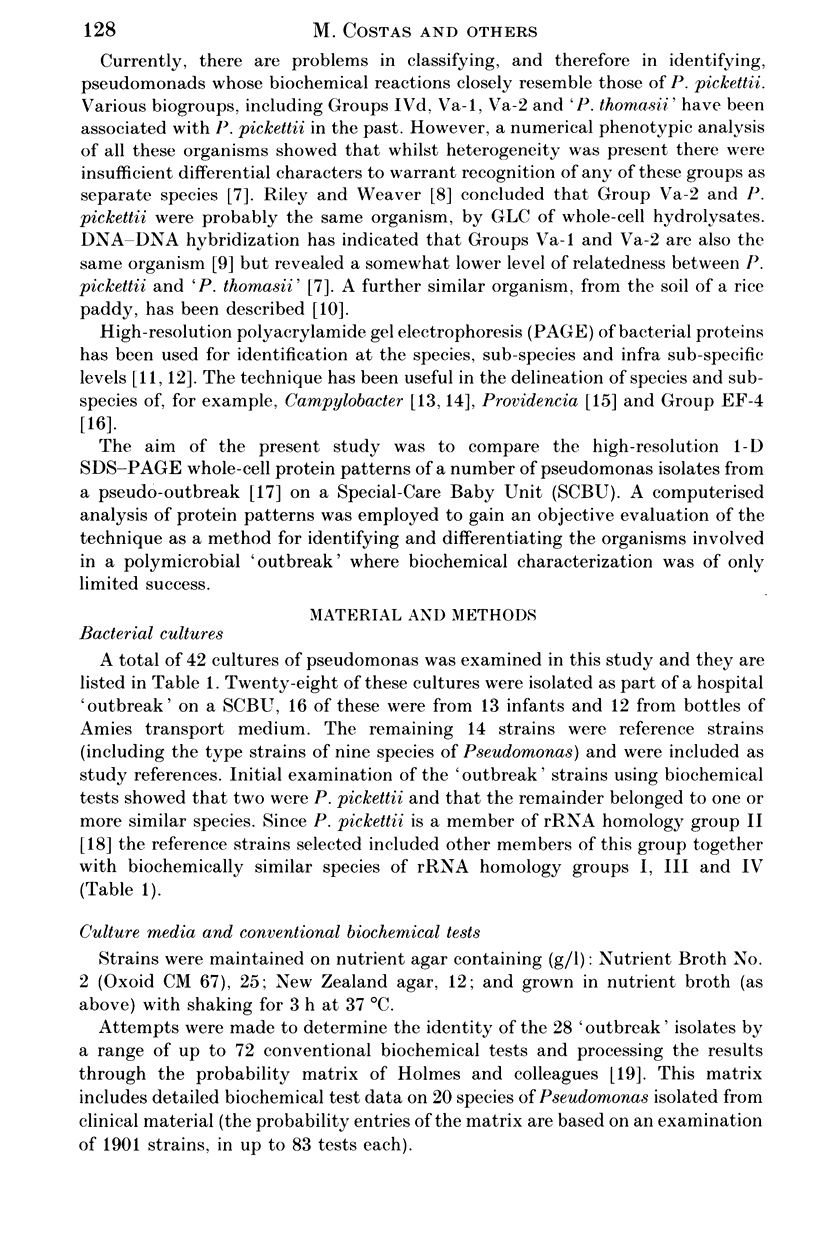
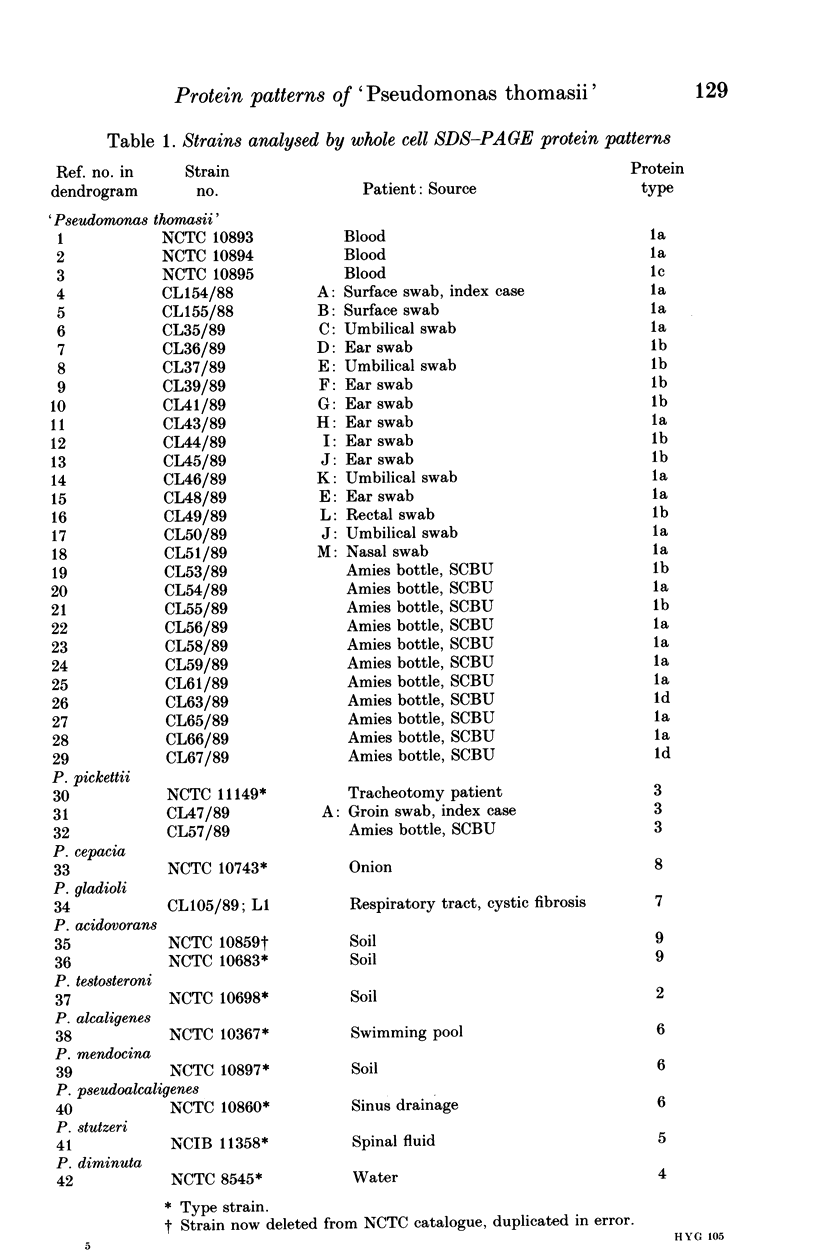
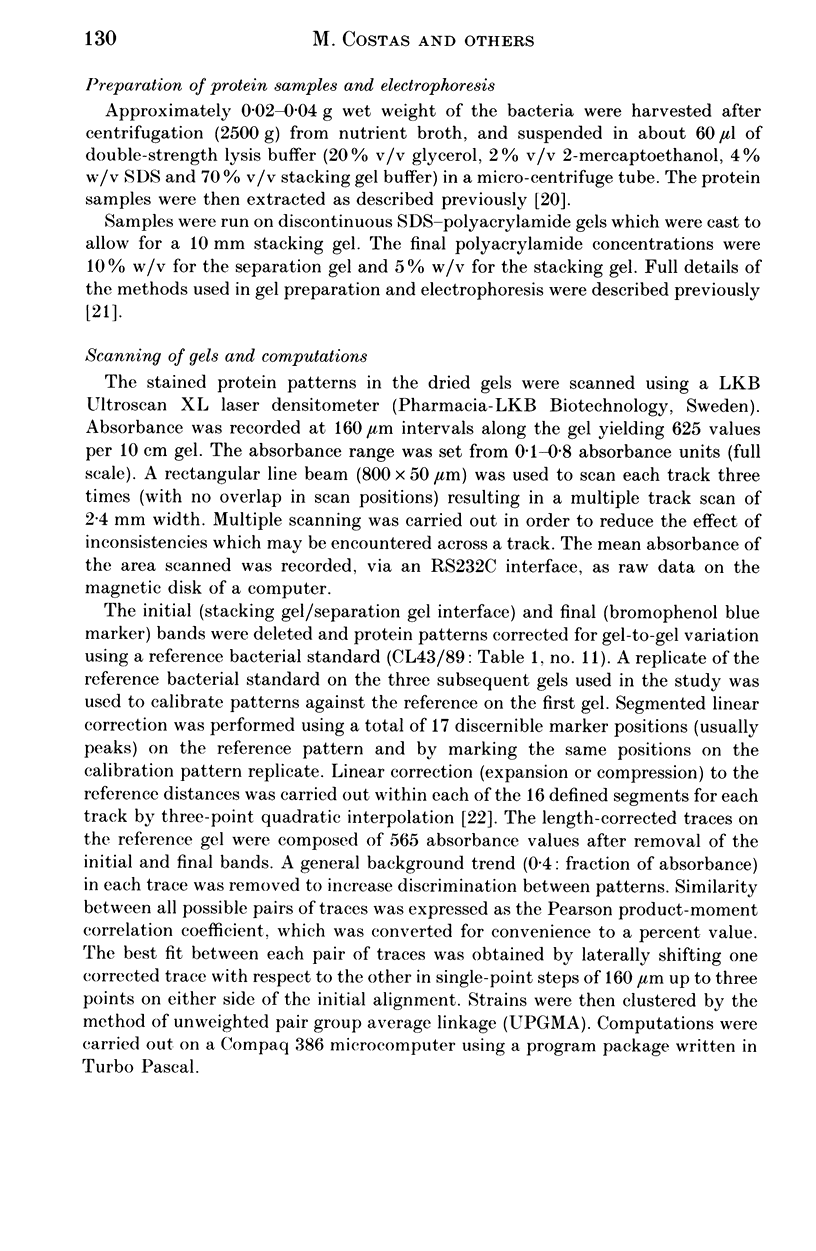
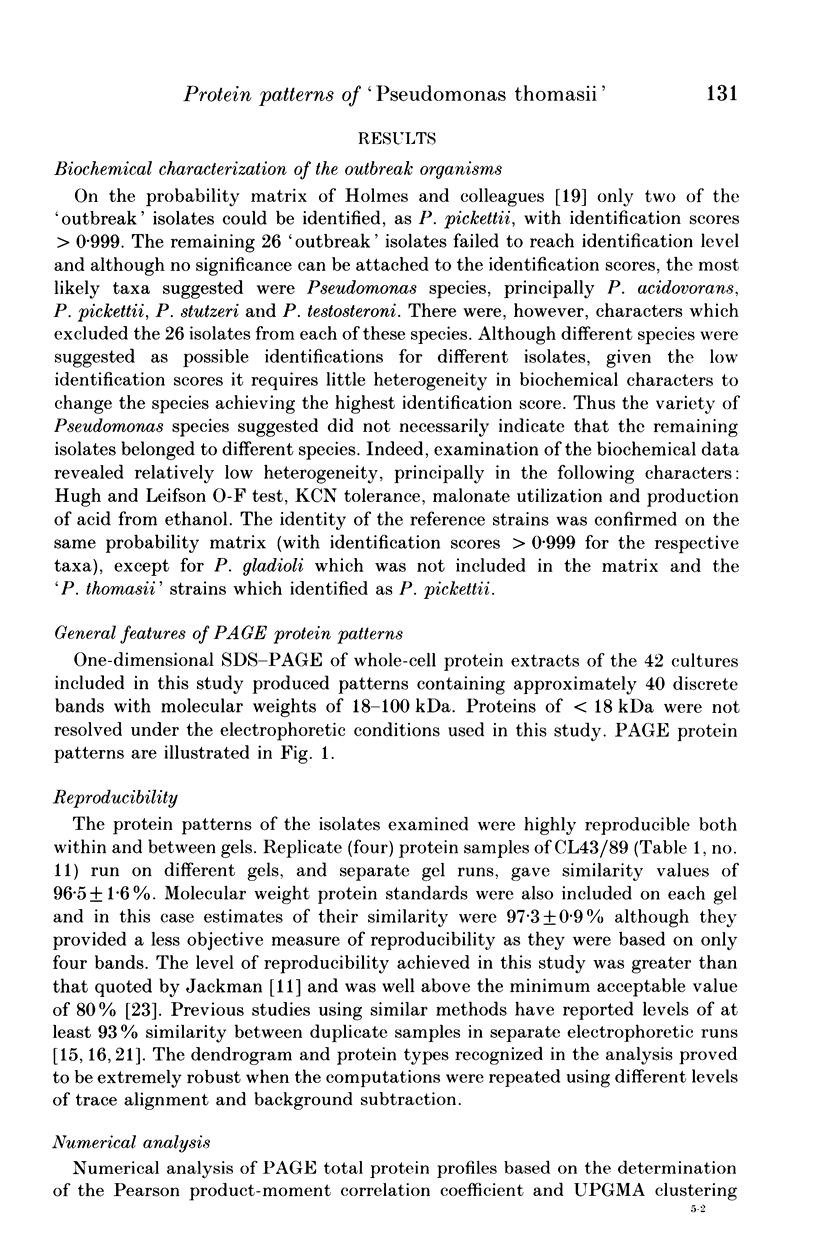
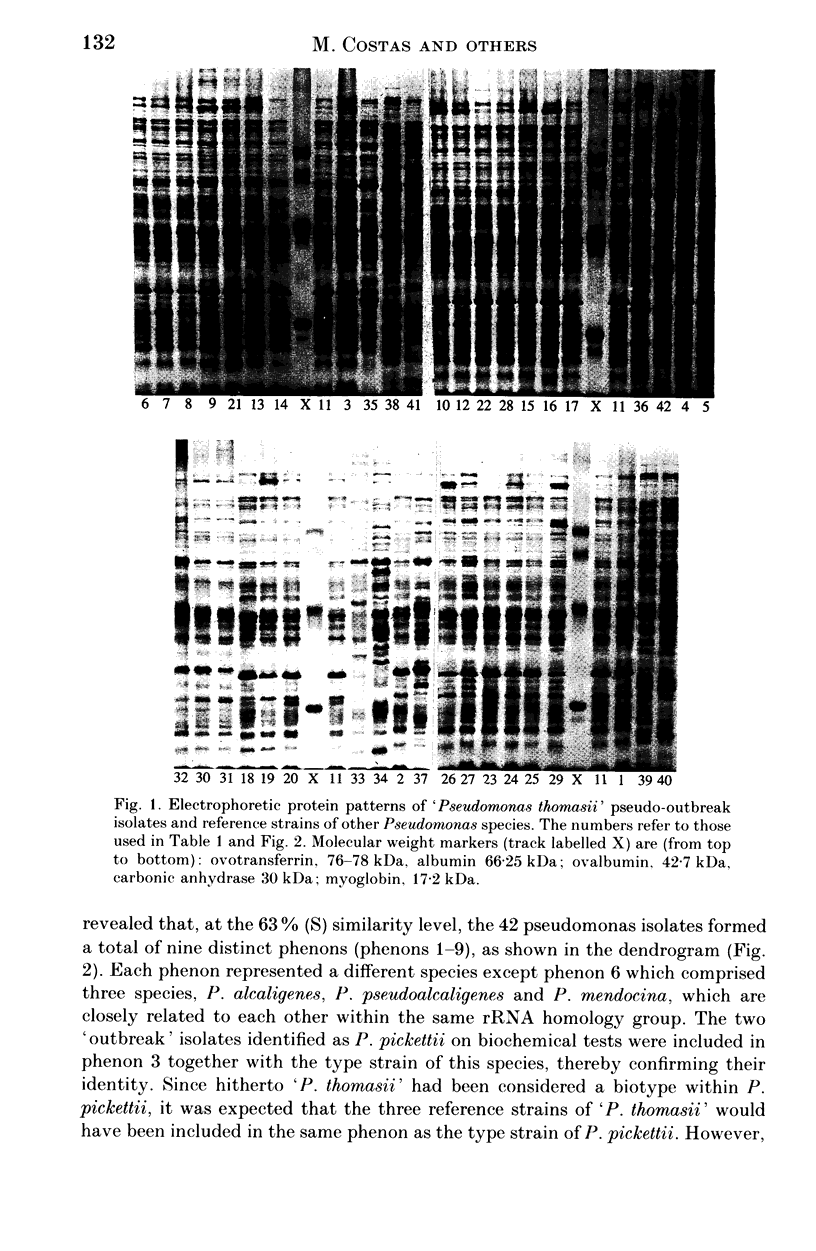
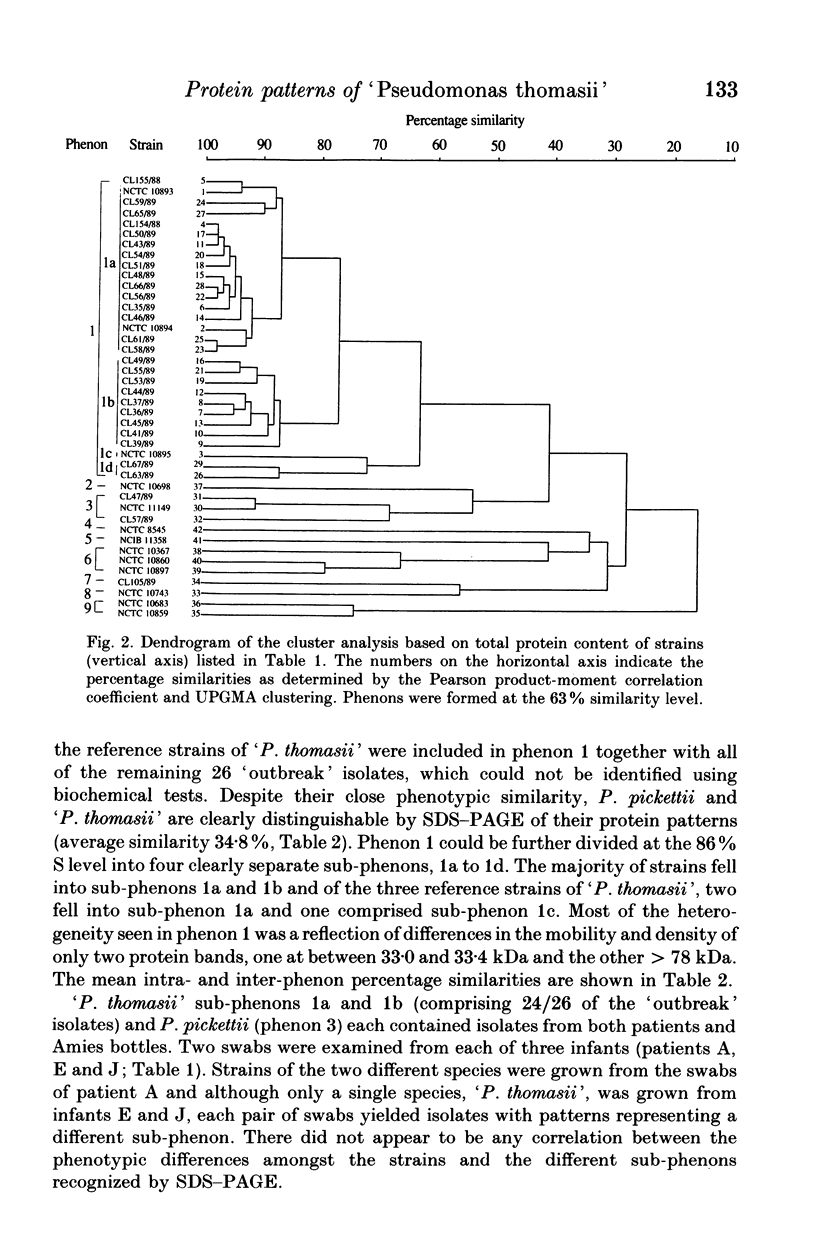
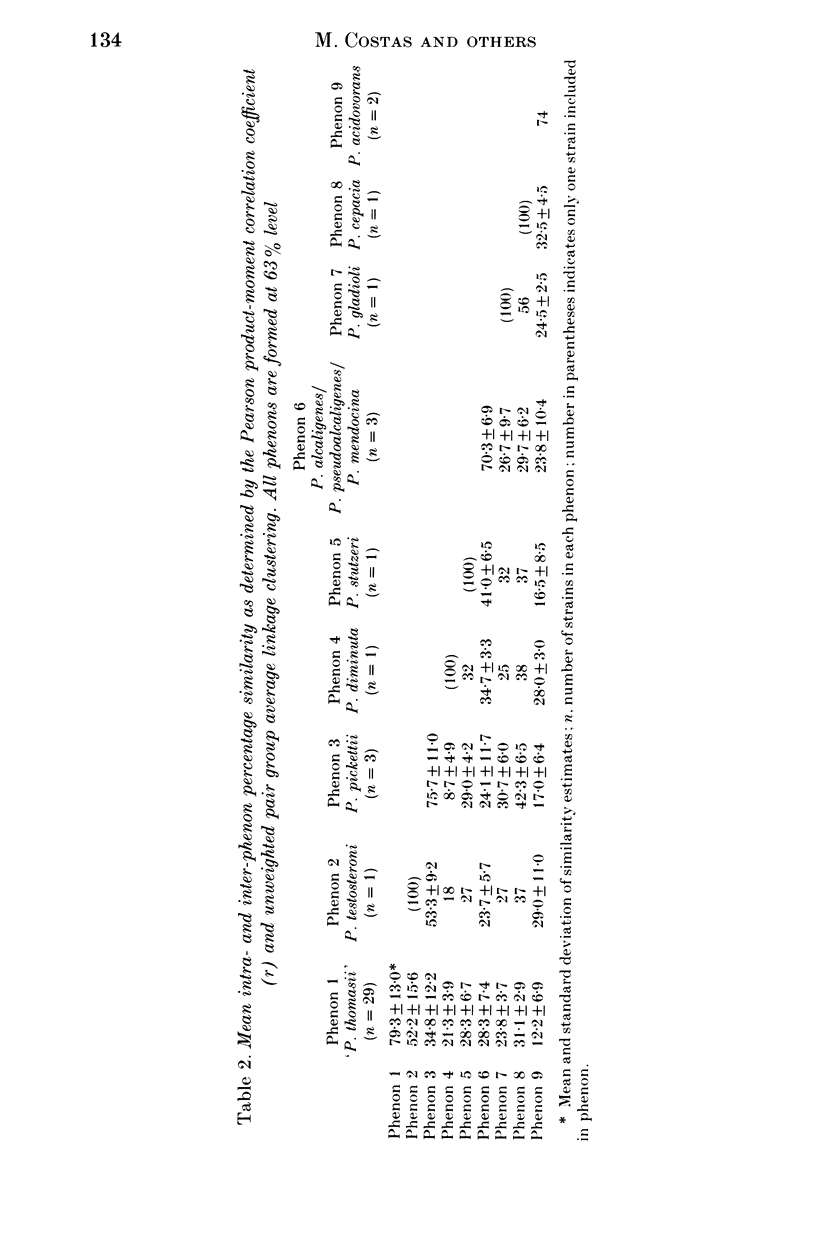
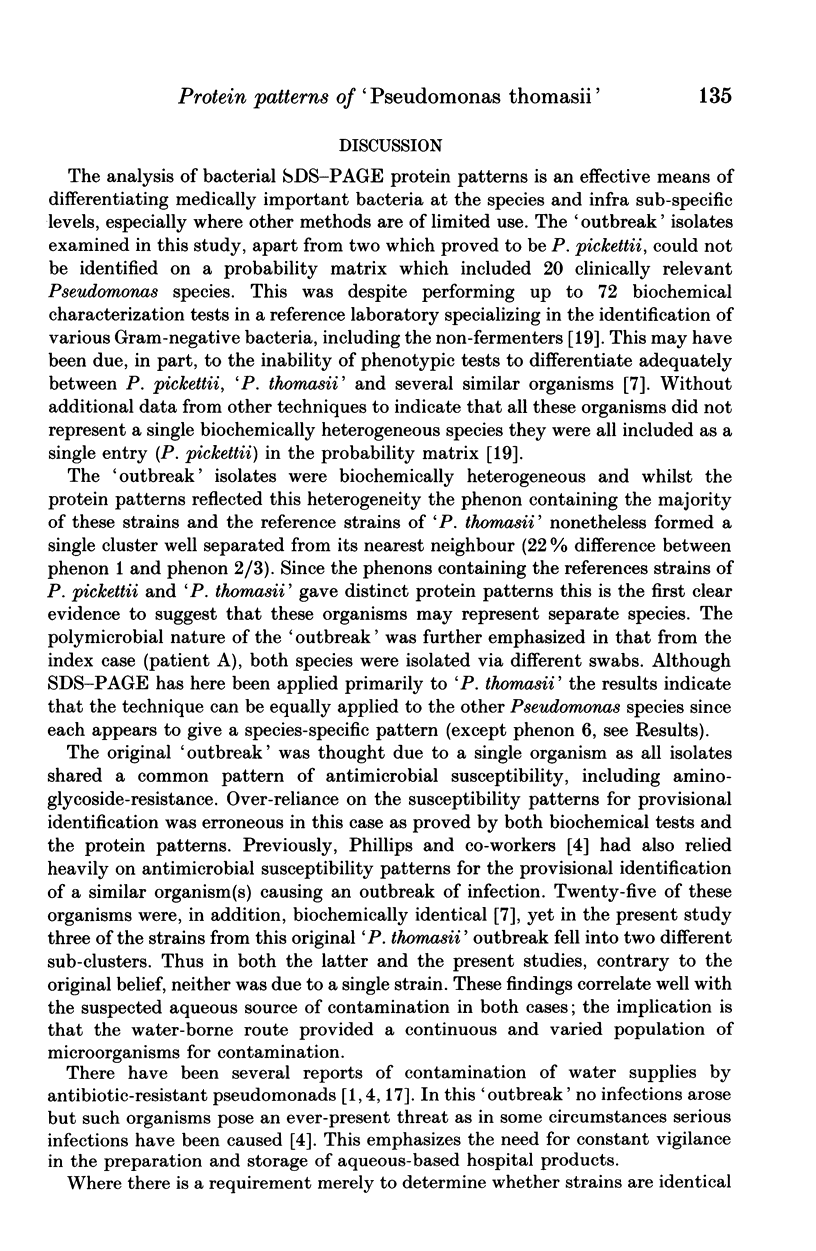
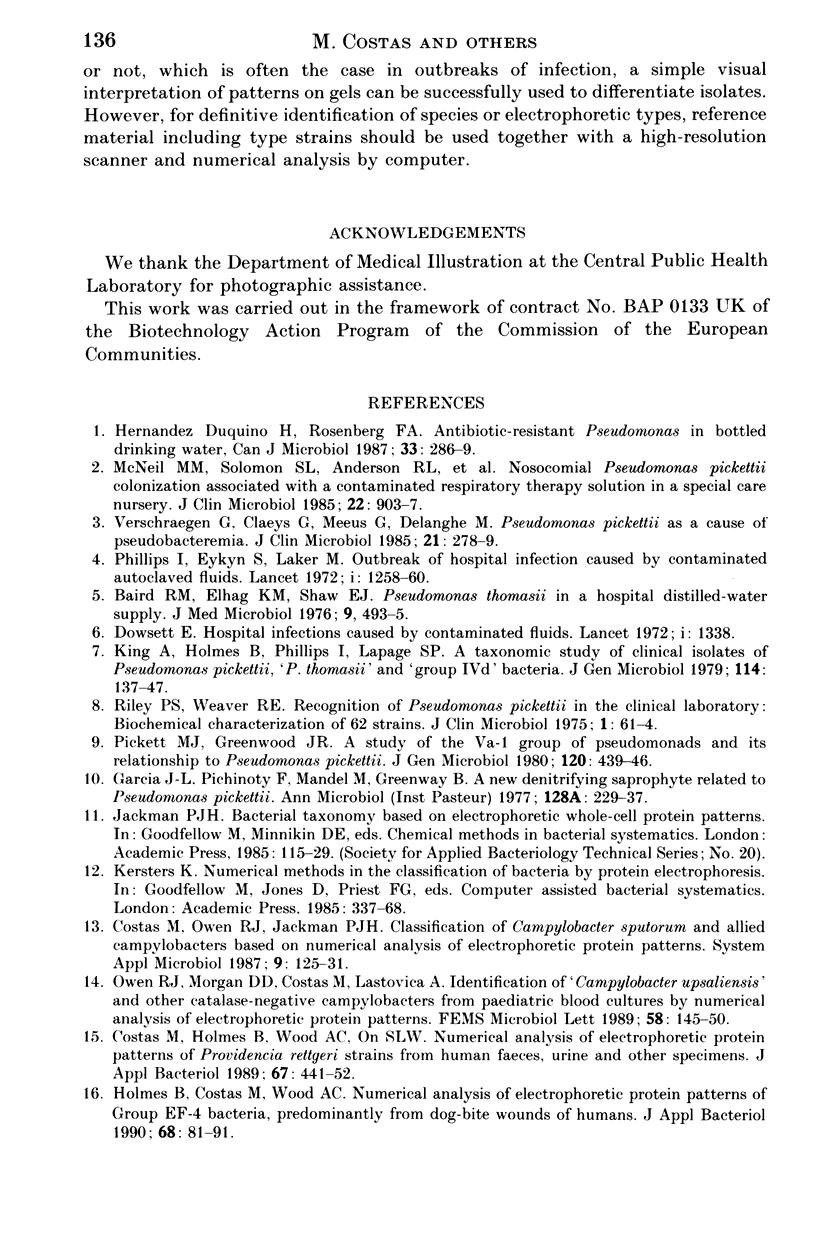
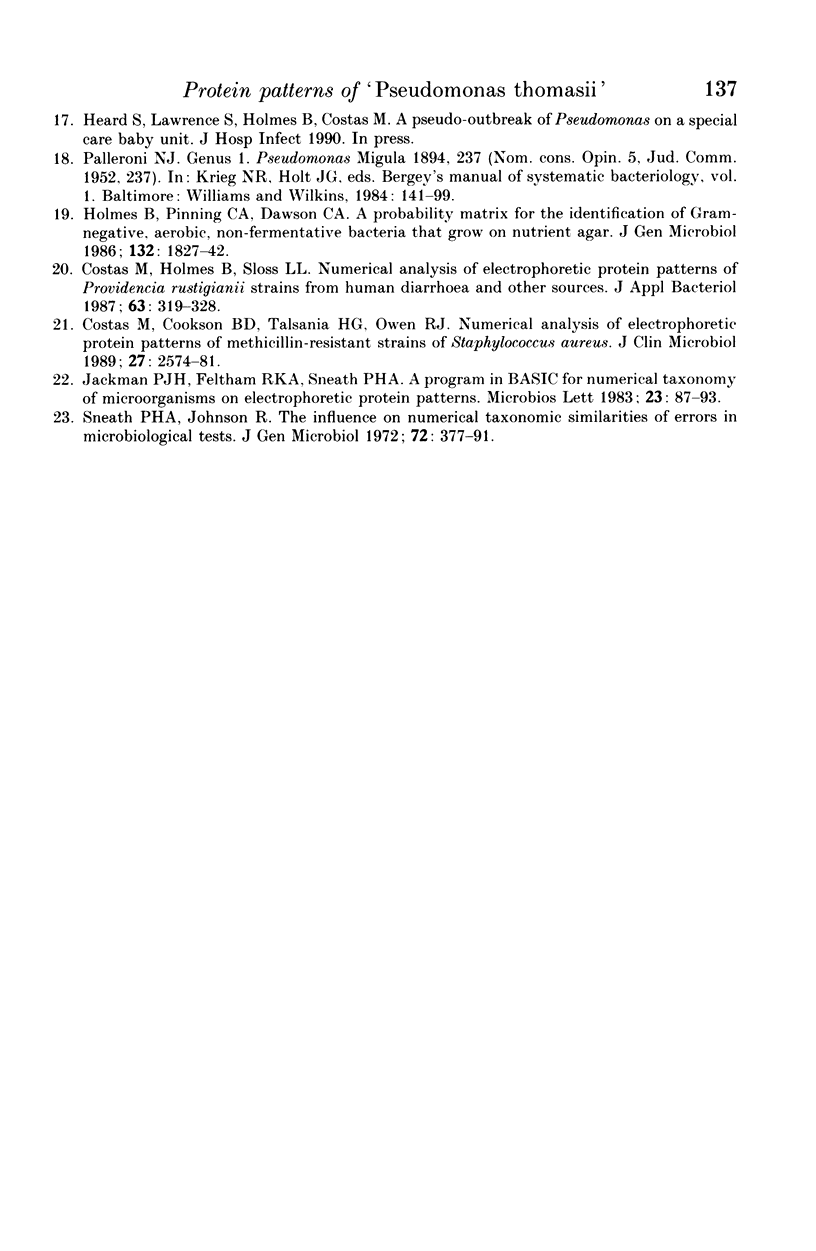
Images in this article
Selected References
These references are in PubMed. This may not be the complete list of references from this article.
- Baird R. M., Elhag K. M., Shaw E. J. Pseudomonas thomasii in a hospital distilled-water supply. J Med Microbiol. 1976 Nov;9(4):493–495. doi: 10.1099/00222615-9-4-493. [DOI] [PubMed] [Google Scholar]
- Costas M., Cookson B. D., Talsania H. G., Owen R. J. Numerical analysis of electrophoretic protein patterns of methicillin-resistant strains of Staphylococcus aureus. J Clin Microbiol. 1989 Nov;27(11):2574–2581. doi: 10.1128/jcm.27.11.2574-2581.1989. [DOI] [PMC free article] [PubMed] [Google Scholar]
- Costas M., Holmes B., Sloss L. L. Numerical analysis of electrophoretic protein patterns of Providencia rustigianii strains from human diarrhoea and other sources. J Appl Bacteriol. 1987 Oct;63(4):319–328. doi: 10.1111/j.1365-2672.1987.tb02709.x. [DOI] [PubMed] [Google Scholar]
- Costas M., Holmes B., Wood A. C., On S. L. Numerical analysis of electrophoretic protein patterns of Providencia rettgeri strains from human faeces, urine and other specimens. J Appl Bacteriol. 1989 Oct;67(4):441–452. doi: 10.1111/j.1365-2672.1989.tb02515.x. [DOI] [PubMed] [Google Scholar]
- Dowsett E. Hospital infections caused by contaminated fluids. Lancet. 1972 Jun 17;1(7764):1338–1338. doi: 10.1016/s0140-6736(72)91064-1. [DOI] [PubMed] [Google Scholar]
- Garcia J. L., Pichinoty F., Mandel M., Greenway B. A new denitrifying saprophyte related to Pseudomonas pickettii. Ann Microbiol (Paris) 1977 Feb-Mar;128(2):229–237. [PubMed] [Google Scholar]
- Hernandez Duquino H., Rosenberg F. A. Antibiotic-resistant Pseudomonas in bottled drinking water. Can J Microbiol. 1987 Apr;33(4):286–289. doi: 10.1139/m87-049. [DOI] [PubMed] [Google Scholar]
- Holmes B., Costas M., Wood A. C. Numerical analysis of electrophoretic protein patterns of Group EF-4 bacteria, predominantly from dog-bite wounds of humans. J Appl Bacteriol. 1990 Jan;68(1):81–91. doi: 10.1111/j.1365-2672.1990.tb02552.x. [DOI] [PubMed] [Google Scholar]
- Holmes B., Pinning C. A., Dawson C. A. A probability matrix for the identification of gram-negative, aerobic, non-fermentative bacteria that grow on nutrient agar. J Gen Microbiol. 1986 Jul;132(7):1827–1842. doi: 10.1099/00221287-132-7-1827. [DOI] [PubMed] [Google Scholar]
- King A., Holmes B., Phillips I., Lapage S. P. A taxonomic study of clinical isolates of Pseudomonas pickettii, 'P. thomasii' and 'group IVd' bacteria. J Gen Microbiol. 1979 Sep;114(1):137–147. doi: 10.1099/00221287-114-1-137. [DOI] [PubMed] [Google Scholar]
- McNeil M. M., Solomon S. L., Anderson R. L., Davis B. J., Spengler R. F., Reisberg B. E., Thornsberry C., Martone W. J. Nosocomial Pseudomonas pickettii colonization associated with a contaminated respiratory therapy solution in a special care nursery. J Clin Microbiol. 1985 Dec;22(6):903–907. doi: 10.1128/jcm.22.6.903-907.1985. [DOI] [PMC free article] [PubMed] [Google Scholar]
- Owen R. J., Morgan D. D., Costas M., Lastovica A. Identification of 'Campylobacter upsaliensis' and other catalase-negative campylobacters from paediatric blood cultures by numerical analysis of electrophoretic protein patterns. FEMS Microbiol Lett. 1989 Apr;49(2-3):145–150. doi: 10.1016/0378-1097(89)90029-3. [DOI] [PubMed] [Google Scholar]
- Phillips I., Eykyn S., Laker M. Outbreak of hospital infection caused by contaminated autoclaved fluids. Lancet. 1972 Jun 10;1(7763):1258–1260. doi: 10.1016/s0140-6736(72)90981-6. [DOI] [PubMed] [Google Scholar]
- Pickett M. J., Greenwood J. R. A study of the Va-1 group of pseudomonads and its relationship to Pseudomonas pickettii. J Gen Microbiol. 1980 Oct;120(2):439–446. doi: 10.1099/00221287-120-2-439. [DOI] [PubMed] [Google Scholar]
- Riley P. S., Weaver R. E. Recognition of Pseudomonas pickettii in the clinical laboratory: biochemical characterization of 62 strains. J Clin Microbiol. 1975 Jan;1(1):61–64. doi: 10.1128/jcm.1.1.61-64.1975. [DOI] [PMC free article] [PubMed] [Google Scholar]
- Sneath P. H., Johnson R. The influence on numerical taxonomic similarities of errors in microbiological tests. J Gen Microbiol. 1972 Sep;72(2):377–392. doi: 10.1099/00221287-72-2-377. [DOI] [PubMed] [Google Scholar]
- Verschraegen G., Claeys G., Meeus G., Delanghe M. Pseudomonas pickettii as a cause of pseudobacteremia. J Clin Microbiol. 1985 Feb;21(2):278–279. doi: 10.1128/jcm.21.2.278-279.1985. [DOI] [PMC free article] [PubMed] [Google Scholar]



